
Mastering manual stick shift driving offers a unique connection to your vehicle, enhancing control and driving enjoyment. It’s a skill that combines coordination, rhythm, and practice.
Why Learn Manual Transmission?
Learning manual transmission enhances driving control and connection to your vehicle. It improves fuel efficiency, reduces repair costs, and boosts driving skills. Mastering a stick shift also expands car rental options and ensures better performance in various conditions. Many drivers find it more engaging and enjoyable than automatic driving. Additionally, it prepares you for handling different vehicles and scenarios, making you a more versatile and confident driver overall.
Benefits of Mastering Stick Shift
Mastering stick shift driving offers numerous benefits, including improved fuel efficiency, lower maintenance costs, and enhanced vehicle control. Drivers gain better acceleration and towing capabilities, making it ideal for various driving conditions. Stick shift cars are often more affordable to purchase and insure. Additionally, driving a manual car reduces the risk of distractions, as it requires active engagement. These advantages make learning stick shift a valuable and rewarding skill for any driver.
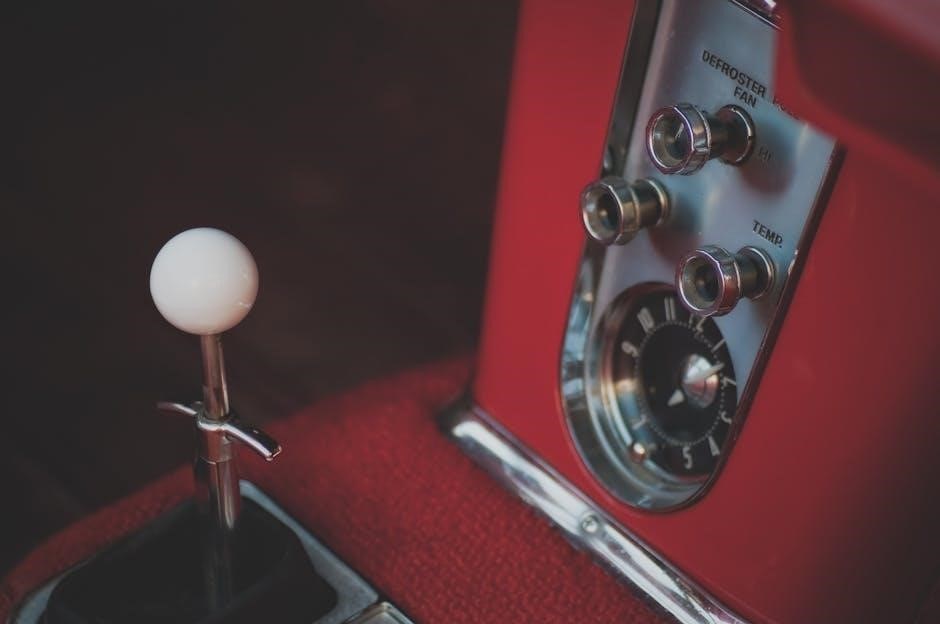
Understanding the Basics of a Manual Car
A manual car operates using a clutch pedal, gearshift, and manual transmission, requiring drivers to engage gears and control torque for smooth acceleration and deceleration.
Key Components of a Manual Transmission Vehicle
A manual transmission vehicle relies on several essential components, including the clutch pedal, gearshift, and transmission system. The clutch disconnects the engine from the transmission, allowing gear changes. The gearshift selects the desired gear, while the transmission houses the gears and shafts. Additionally, the flywheel and pressure plate work with the clutch to engage and disengage power. Understanding these components is crucial for effective control of the vehicle during driving lessons.
Clutch, Brake, and Gas Pedals: Their Roles
The clutch pedal is used to disconnect the engine from the transmission, allowing smooth gear shifts. The brake pedal controls the vehicle’s stopping power, while the gas pedal regulates acceleration. Coordinating these pedals is essential for maintaining control and ensuring seamless transitions between gears. Proper timing and balance between the clutch and gas pedals prevent stalling, while the brake helps manage speed and safety. Mastering their roles is fundamental for effective manual driving.
Preparing for Your First Lesson
Research reputable instructors, understand basic car mechanics, and mentally prepare for coordination challenges. Finding the right teacher and mindset sets the stage for success.
Choosing the Right Instructor or Driving School
Research reputable driving schools and instructors specializing in manual transmission. Look for experienced teachers with a proven track record and positive reviews. Ensure they offer personalized lessons tailored to your skill level and goals. Schools like SHIFTR and Driven2Drive provide expert guidance, while others guarantee success. Many instructors focus on building confidence and proficiency. Read reviews, ask about their teaching methods, and ensure they cover essential topics like clutch control and smooth shifting. Some schools even offer specialized courses for sports cars or heavy vehicles, catering to diverse needs.
What to Expect in Your First Driving Lesson
Your first manual driving lesson will focus on the basics of operating a stick-shift car. Expect to start with an overview of the clutch, brake, and gas pedals, followed by hands-on practice. Instructors will guide you through starting the car, shifting gears, and gradually progressing to smooth acceleration. Lessons typically begin in a safe, open area to minimize stress. The goal is to build confidence and familiarity with the vehicle’s mechanics. Be prepared to stall initially—it’s part of the learning process!
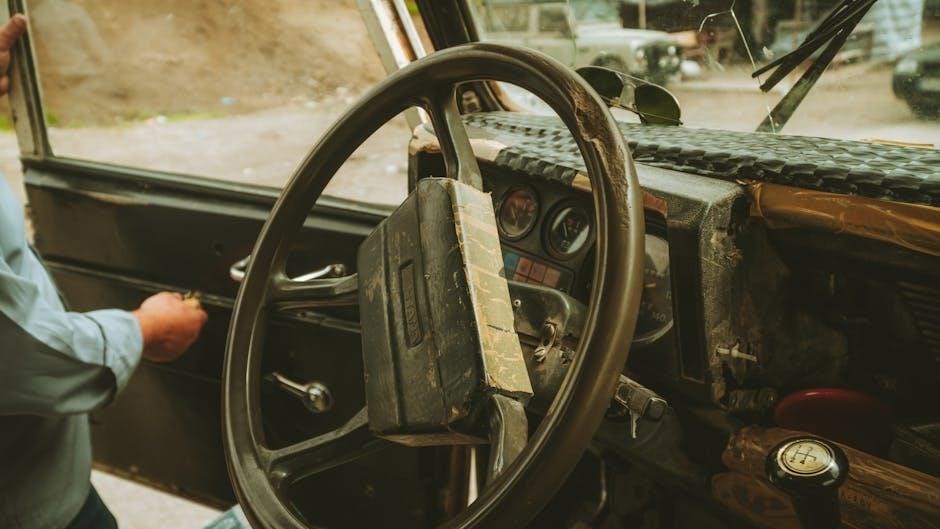
Mastering the Clutch and Gear Shifting
Mastering the clutch and gear shifting requires precise coordination. The clutch disconnects engine power, allowing smooth shifts. Practice shifting gears seamlessly to achieve fluid acceleration and control.
The Mechanics of the Clutch System
The clutch system is a crucial component in manual transmission vehicles. It consists of a clutch pedal, pressure plate, and friction disc. When the pedal is pressed, it disengages the engine from the transmission, allowing gear shifts without grinding. Releasing the pedal gradually reconnects the engine. Proper use of the clutch ensures smooth acceleration and prevents wear on the system, requiring careful coordination with gear shifts to maintain control and efficiency while driving.
How to Shift Gears Smoothly
Smooth gear shifting requires precise coordination between the clutch pedal and gearstick. Press the clutch fully, use the gearstick to select the desired gear, and release the clutch slowly while accelerating. Practice shifting through gears sequentially, listening to engine speed cues; Avoid riding the clutch, as it can cause wear. Smooth transitions ensure a comfortable ride and better control, especially when accelerating or decelerating. Regular practice helps develop muscle memory for seamless shifting in various driving conditions.
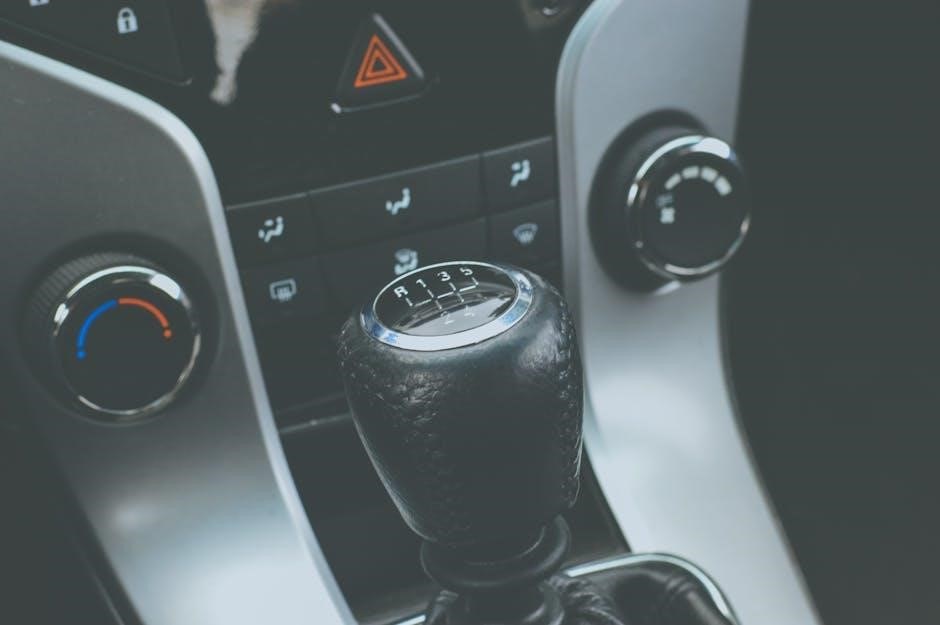
Starting and Stopping the Vehicle
Mastering smooth starts and stops is essential for manual driving. Use the clutch and brake pedals gradually to avoid jerking or stalling the car.
How to Start on a Flat Surface
Starting on a flat surface begins with pressing the clutch fully down and shifting into first gear. Slowly release the clutch while pressing the accelerator gently. As the car begins to move, shift into higher gears smoothly. Keep the car at a steady speed, using the brake to maintain control. Practice this process repeatedly to build muscle memory and confidence. Always ensure the parking brake is disengaged before starting.
Starting on an Incline or Decline
Starting on an incline or decline requires extra care to avoid rolling or stalling. On an incline, press the clutch fully, shift into first gear, and slowly release the clutch while accelerating gently. Use the parking brake if needed. On a decline, downshift before starting to control speed. Feather the clutch and brakes to maintain steady movement. Practice these techniques in a safe, empty area to build confidence and control in varied terrains.
Common Challenges and Solutions
Common challenges include stalling, difficulty coordinating clutch and accelerator, and managing stop-and-go traffic. Practice in safe, empty areas and use proper techniques to build confidence and skill.
How to Avoid Stalling the Car
To avoid stalling, press the clutch slowly and shift into first gear. As you release the clutch, gently press the accelerator. Listen to the engine’s tone; it should rev slightly. Avoid sudden movements and practice in a flat, open space. If the car starts to stall, remain calm and restart. Consistent practice improves coordination between the clutch and accelerator, reducing stalling incidents.
Overcoming the Fear of Stalling
Stalling is a normal part of learning manual driving. To overcome the fear, focus on staying calm and patient. Practice in a safe, open area where mistakes won’t cause stress. Press the clutch slowly and listen to the engine’s rhythm. Gently ease off the clutch while accelerating. Remember, stalling doesn’t mean failure—it’s a step toward mastery. Consistent practice builds confidence and improves coordination between the clutch and accelerator.
Advanced Techniques for Stick Shift Driving
Mastering advanced techniques like downshifting and heel-to-toe shifting enhances control and precision, especially in high-performance or challenging driving conditions.
Downshifting for Better Control
Downshifting is an advanced technique that enhances control, especially during deceleration or descending hills. By shifting to a lower gear before braking, you reduce braking distance and maintain stability. Smoothly press the clutch, shift gears, and release slowly while listening to engine RPMs. This method provides better traction and prevents wheel lockup, making it safer and more efficient. Practice downshifting in various scenarios to master the timing and coordination required for precise control.
Heel-to-Toe Shifting in Manual Cars
Heel-to-toe shifting is a refined technique used to maintain speed through corners. It involves pressing the clutch with the heel while using the toe to blip the throttle, matching RPMs to the gear. This seamless downshift prevents wheelspin and enhances control. Practice this method on closed courses or empty roads to master timing and pedal coordination. Proper heel-to-toe shifting improves lap times and driving precision, making it a valuable skill for both casual and performance drivers.

Practicing in Different Driving Conditions
Practicing in various conditions, such as traffic, stop-and-go situations, and inclines, helps improve adaptability and control when driving a manual car.
Driving in Traffic and Stop-and-Go Situations
Mastering manual driving in traffic requires smooth clutch control and precise gear shifting. Feathering the clutch at low speeds helps maintain control, while downshifting prevents rollback on inclines. Avoid riding the clutch to reduce wear and ensure smooth acceleration. Practice in light traffic before tackling heavy congestion, focusing on seamless transitions between gears and brakes. This builds confidence and coordination, essential for navigating stop-and-go situations efficiently.
Mastering Highway Driving with a Manual Car
Highway driving with a manual car requires smooth gear operation at higher speeds. Maintain consistent acceleration, using the clutch and accelerator seamlessly for merging and maintaining speed. Downshift before hills or when needing more control, and upshift smoothly to avoid jerking. Practice handling varied conditions like inclines and traffic flow. Mastering these techniques builds confidence and ensures efficient, enjoyable highway driving while reducing wear on the transmission.
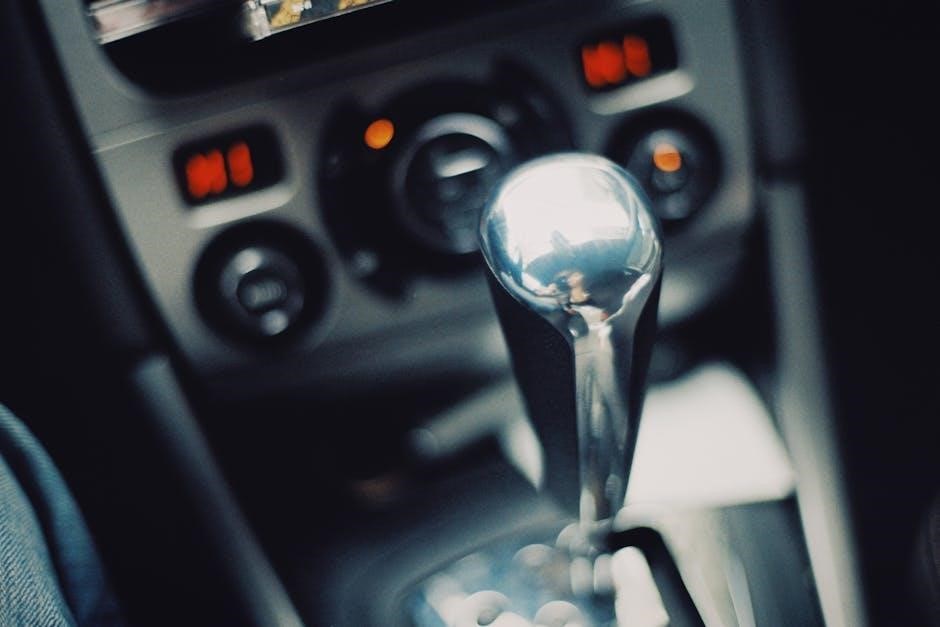
Choosing the Right Vehicle for Practice
Selecting the right car for learning is crucial. Older models with simpler systems are ideal for practice, as they are more forgiving and cost-effective.
Why Older Models Are Better for Learning
Older models are often preferred for learning stick shift due to their simpler mechanics and lower cost. They typically have a more forgiving clutch system, making it easier to practice without the pressure of damaging an expensive vehicle. The straightforward design of older cars allows learners to focus on mastering the basics of manual driving without the distractions of advanced technology. This makes them an ideal choice for building confidence and proficiency behind the wheel.
Pros and Cons of Learning in a Sports Car
Learning to drive a stick shift in a sports car can be an exhilarating experience, offering precise control and a dynamic feel. However, sports cars often have more sensitive clutches and higher RPM ranges, which can be challenging for beginners. Additionally, the cost of repairs if mistakes occur may be higher. While it can build confidence and skill quickly, it may also feel intimidating for new learners. Ultimately, it’s a great option for those eager to master manual driving in a more engaging way, but it requires patience and focus.
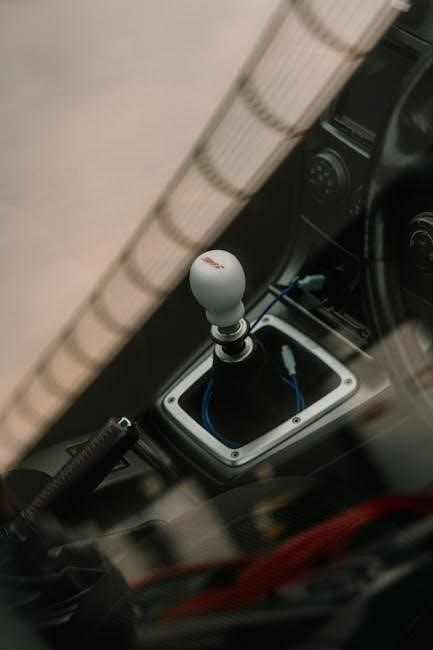
The Role of an Instructor in Stick Shift Lessons
An instructor provides personalized guidance, builds confidence, and offers emotional support, helping learners understand mechanics and master shifting techniques for smooth and confident manual driving.
What Makes a Good Driving Instructor?
A good driving instructor is patient, experienced, and skilled in teaching manual transmission. They tailor lessons to individual needs, ensuring a safe and supportive environment. Clear communication, positive attitude, and adaptability are key. A great instructor breaks down complex techniques into simple steps, helping learners build confidence and mastery. They also provide constructive feedback and encourage practice, fostering improvement and a smooth learning curve for stick shift driving.
How to Get the Most Out of Your Lessons
To maximize your stick shift lessons, set clear goals with your instructor and practice consistently. Focus on understanding the mechanics of the clutch and gears. Engage actively by asking questions and reflecting on feedback. Stay relaxed and patient during sessions, as tension can hinder progress. Additionally, practice regularly, even in short sessions, to build muscle memory and confidence. This approach ensures steady improvement and a smoother learning experience.
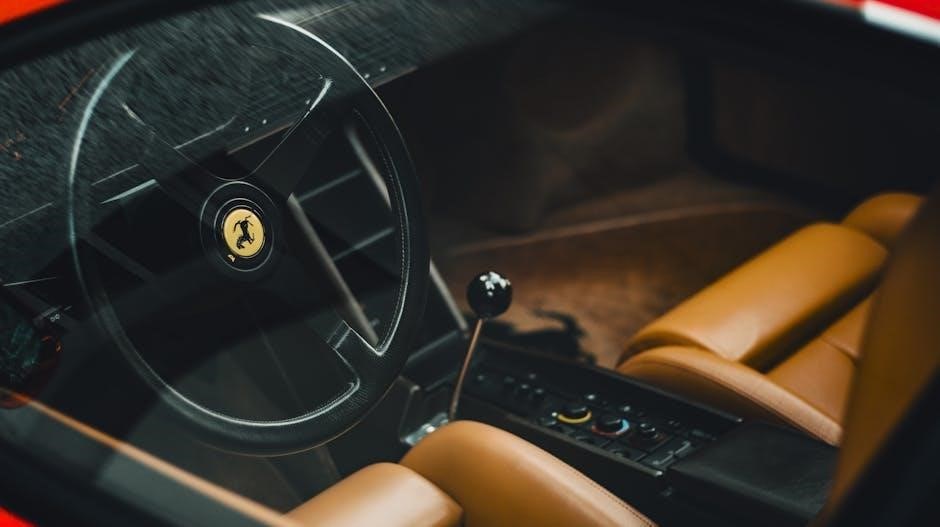
Practice Locations and Tips
Find a quiet, open space like an empty parking lot to practice stick shift driving. Start on flat surfaces before progressing to inclines, focusing on smooth transitions.
Best Places to Practice Stick Shift Driving
An empty parking lot is ideal for practicing stick shift driving, as it provides a safe, open space to master clutch control and gear shifting. Quiet neighborhood streets with minimal traffic are also great for initial lessons. Once comfortable, progress to slight inclines or declines to practice balancing the clutch and brake. Avoid busy areas to minimize stress and focus on smooth transitions. Starting on flat surfaces before moving to hills ensures a solid foundation.
Tips for Practicing Without an Instructor
Start in a safe, open area like an empty parking lot to avoid traffic and stress; Practice basic clutch control by feeling the “biting point” where the engine engages. Begin on flat ground before moving to inclines. Use online tutorials or guides for step-by-step instructions. Focus on smooth shifts and gradual acceleration. Avoid stalling by listening to engine RPMs and coordinating clutch release with gas pedal input. Gradually challenge yourself with hills and varying conditions to build confidence and skill.
Maintenance and Care of a Manual Car
Regular clutch inspections and transmission fluid checks are essential for smooth operation. Scheduled maintenance ensures longevity and performance of your manual vehicle.
How to Check and Maintain the Clutch System
Regular inspections of the clutch system are crucial for optimal performance. Check the clutch pedal’s free play and ensure it engages smoothly. Inspect the clutch cable or hydraulic system for leaks or wear. Replace worn clutch plates or pressure plates promptly to avoid costly repairs. Proper maintenance ensures smooth gear shifts and prevents stalling. Always refer to your vehicle’s manual for specific guidance on clutch care and replacement intervals.
Understanding the Transmission Fluid
Transmission fluid is essential for lubricating the gears and components of a manual car. It prevents overheating and ensures smooth gear transitions. Regularly check the fluid level and condition, topping it up as needed. Avoid overfilling, as this can damage the system. Replace the fluid every 30,000 to 60,000 miles, depending on your vehicle’s manual. Clean, high-quality fluid is crucial for maintaining the longevity and performance of your manual transmission system.
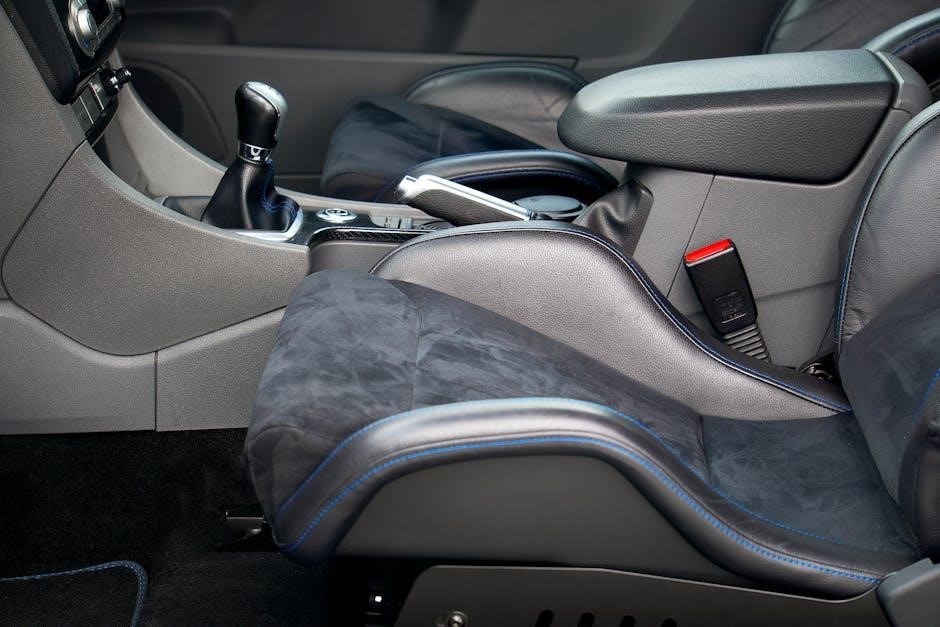
Safety Tips for Manual Driving
Always wear a seatbelt and ensure passengers do the same. Stay alert and avoid distractions while driving. Be prepared for emergencies by keeping an emergency kit in the car.
Essential Safety Practices
Mastering stick shift requires focus and safety. Always wear a seatbelt, keep loose items secure, and avoid distractions. Use mirrors for visibility and check blind spots. Be cautious in heavy traffic and inclines. Familiarize yourself with the vehicle’s controls and practice in a safe, open area. Keep an emergency kit in the car and stay alert for potential hazards. Proper hand positioning on the wheel and smooth gear shifting are crucial for maintaining control and ensuring a safe driving experience.
What to Do in Case of an Emergency
In an emergency, stay calm and act quickly. If your car stalls, shift to neutral and apply the parking brake. Engage the hazard lights for visibility. Avoid sudden movements and keep your seatbelt fastened. If you lose control, ease off the accelerator and steer straight. For breakdowns, pull over safely and call for assistance. Always carry an emergency kit with reflectors, a flashlight, and a phone charger. Practice these steps to ensure safety and confidence while driving a manual car.
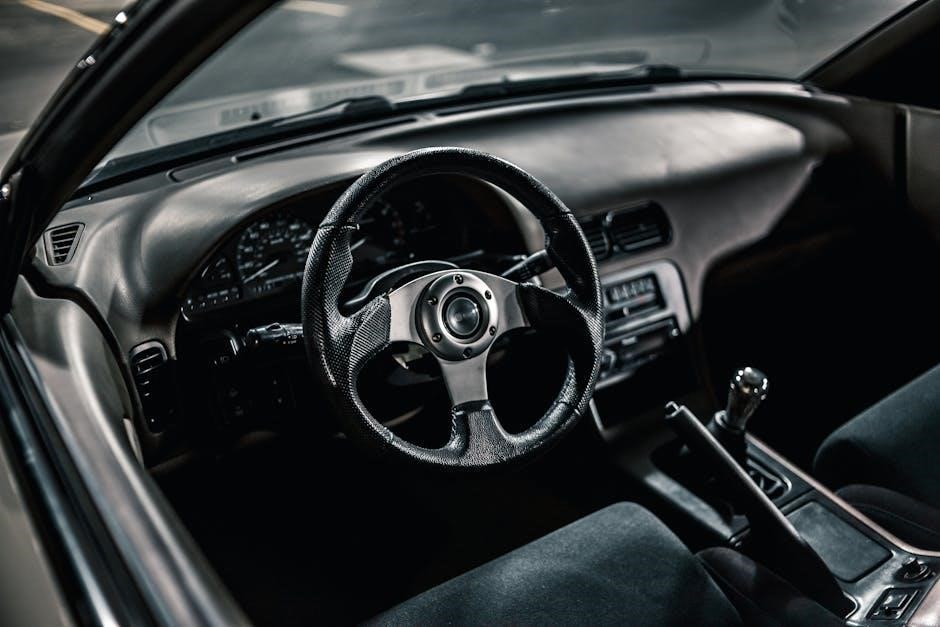
Frequently Asked Questions
Common questions include costs, lesson duration, and mastery time. Many ask about guarantees and instructor qualifications, ensuring a smooth learning experience for manual driving.
Is Learning Stick Shift Worth It?
Learning stick shift is highly beneficial, offering better control, fuel efficiency, and cost-effectiveness. It enhances driving skills, connects you to your vehicle, and provides a sense of accomplishment. Many find it valuable for its practicality and long-term benefits, making it worth the effort and time invested in mastering manual driving.
How Long Does It Take to Master Manual Driving?
Mastery of manual driving varies by individual, typically requiring consistent practice. Beginners may grasp basics in a few weeks, while smooth, confident driving can take a few months. Regular lessons and practice sessions accelerate the learning process, helping drivers overcome challenges like stalling and gear shifting.
Mastering manual driving takes time and practice, but it offers a rewarding sense of control and accomplishment. Stay committed, and you’ll become a confident stick shift driver.
Final Tips for Success
Start in a safe, open area to build confidence. Practice clutch control smoothly and consistently. Focus on listening to the engine’s rhythm to avoid stalling. Gradually incorporate different driving conditions, such as hills and traffic, to refine your skills. Stay relaxed and patient, as mastery takes time. Celebrate small victories to stay motivated. With dedication and practice, you’ll become a proficient stick shift driver, ready to handle any road with confidence and ease.
Encouragement for New Learners
Learning to drive a manual car can seem daunting, but with persistence, you’ll master it. Start in a safe, open space and celebrate small victories. Every driver stalls at first—it’s part of the process. Stay relaxed, listen to the engine, and trust your instincts. Expert instructors can guide you, but practice is key. Over time, you’ll gain confidence and enjoy the control manual driving offers. Keep going, and remember, every driver began where you are now!